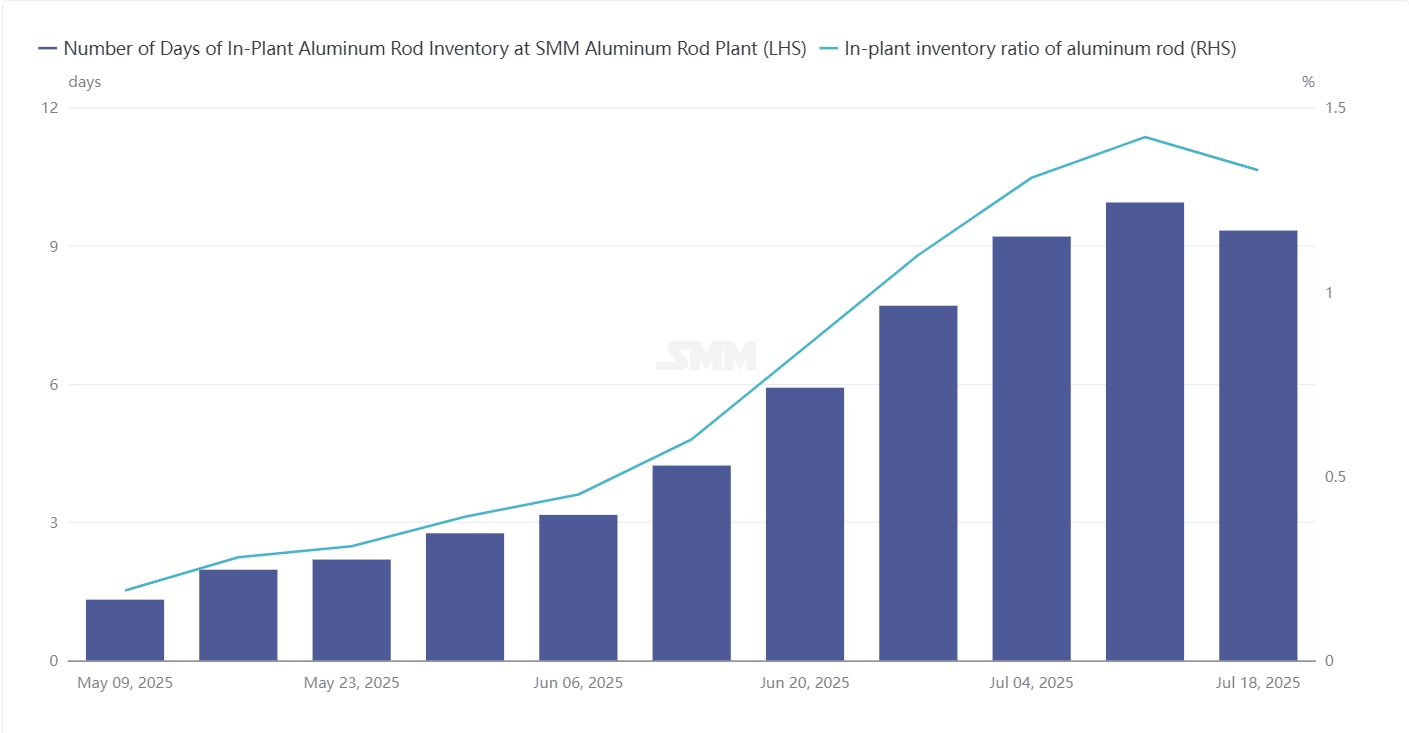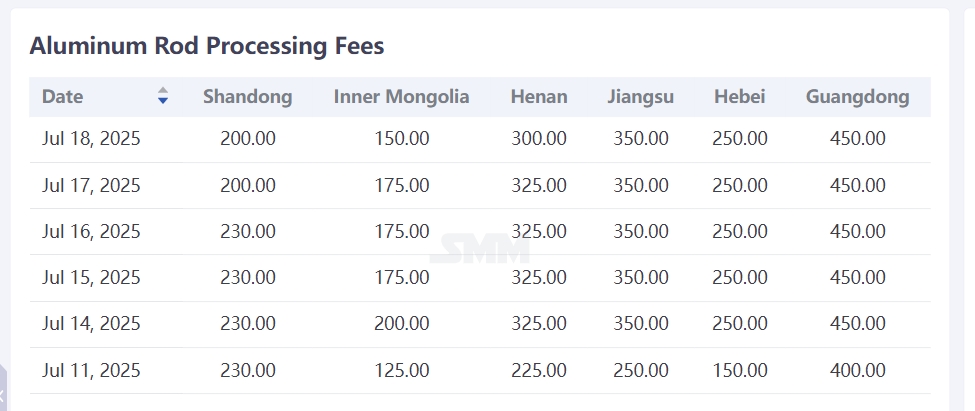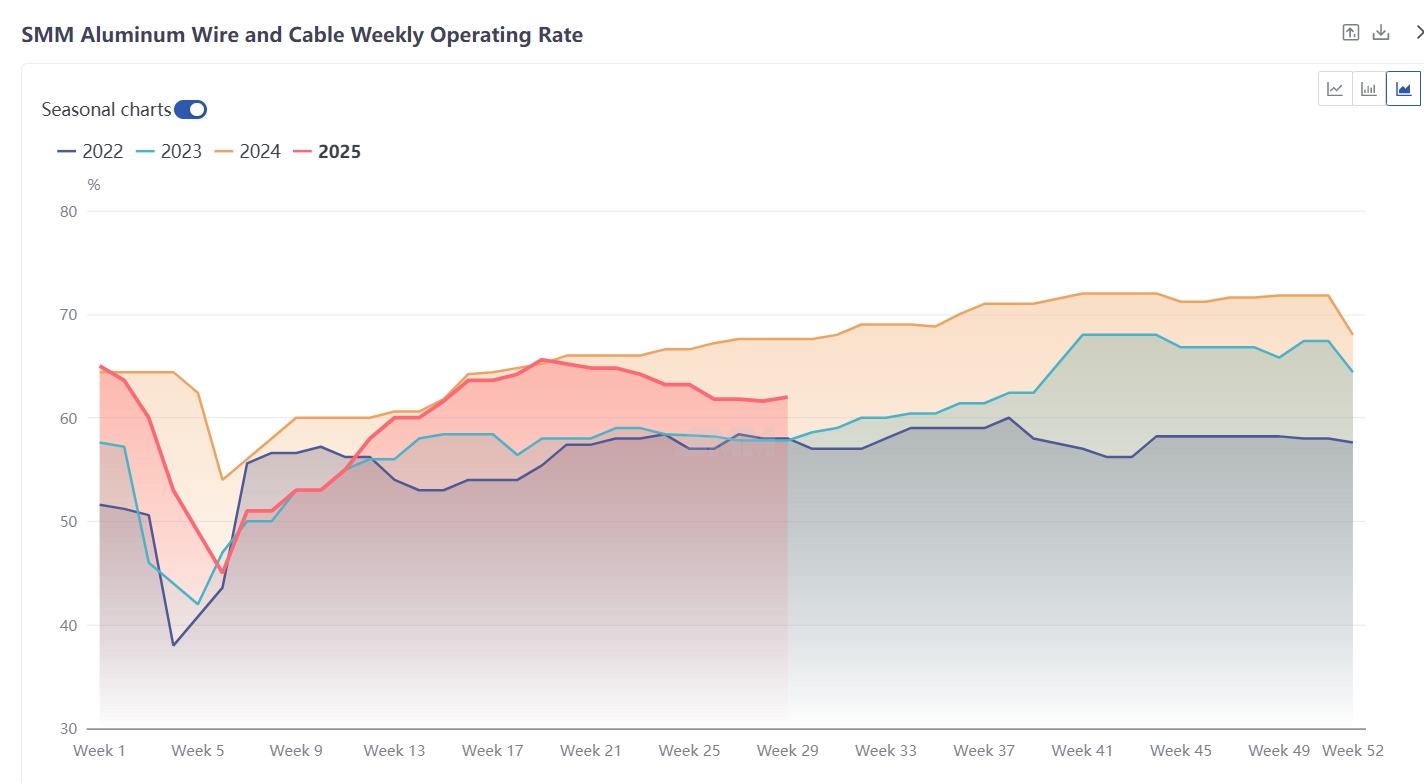






According to SMM statistics, as of July 18th, the days of inventories at domestic aluminum rod plants stood at 9.33 days, a decrease of 0.61 days WoW. In terms of inventory ratio, the domestic aluminum rod plant inventory ratio was recorded at 1.33, a decrease of 0.09 from the previous week. Since mid-to-late May, the transaction enthusiasm in the aluminum rod market has begun to decline. Although production and sales were balanced previously, there was a trend of slow increase in in-plant inventory. After June, market transactions became increasingly sluggish, and with the arrival of the aluminum price squeeze, market purchasing sentiment became increasingly weak. Manufacturers' in-plant inventory entered a stage of rapid growth, with the highest number of days of inventories approaching 10 days. However, as July progressed, aluminum rod manufacturers gradually cut production due to financial pressure. Although the supply-side pressure continued to increase, there was a marginal improvement trend. Additionally, the price center loosened during the week, and downstream rigid demand restocked, with enthusiasm for production and purchasing somewhat recovering, thus driving inventory down. SMM believes that the current market is still in an oversupply situation, with only marginal improvement in weekly transactions. Whether subsequent market transactions can continue remains uncertain, and the focus should still be on whether the downstream aluminum wire and cable industry can enter a concentrated delivery cycle. Given that downstream consumption remains unclear, it is expected that in the short term, the days of inventories at aluminum rod plants will continue to fluctuate at highs, ranging from 8 to 10 days.

In terms of processing fees, aluminum prices formed a trend of first falling and then rising during the week. Although the price center loosened somewhat, it still maintained a strong oscillation and had not smoothly entered a correction cycle. Considering the pullback in the aluminum price center, suppliers and rod plants, taking into account their own costs, raised processing fees, with the market showing reluctance to budge on prices. The aluminum rod processing fee slightly recovered. However, there were some speculators in the market who suppressed processing fees to seize orders, intending to deliver after the aluminum price pulls back, causing certain disturbances to market processing fees. Due to the slight wait-and-see sentiment in the downstream, aluminum rod transactions somewhat recovered during the week amid the rhythm of rigid demand restocking, with top-tier enterprises reporting increased shipments. As of July 18th, 2025, the ex-factory price of aluminum rods in the Shandong market was 200 yuan/mt, a decrease of 30 WoW; in the Henan market, it was 300 yuan/mt, an increase of 75 WoW; in the Inner Mongolia market, the processing fee was reported at 150 yuan/mt, an increase of 25 WoW. In trading areas, the delivered price in the Hebei market was 250 yuan/mt, an increase of 100 WoW; in the Jiangsu market, it was 350 yuan/mt, an increase of 100 WoW; in the Guangdong market, it was 450 yuan/mt, an increase of 50 WoW. Looking ahead, although downstream consumption is still in an off-season atmosphere, transaction performance during the week has somewhat recovered. Additionally, with the upcoming delivery cycle for power transmission and transformation and ultra-high voltage orders in August, it is expected that there will be a slow transition to a concentrated delivery cycle from July to August. Downstream consumption is expected to be strong in the long term but weak in the short term. Considering that in-plant inventory is still accumulating and time is needed to consume inventory, it is expected that the ex-factory processing fee of aluminum rods in Shandong will range from 200 to 300 yuan/mt in the short term. (Unit: yuan/mt)

Aluminum wire and cable: This week, the operating rate of leading enterprises in the aluminum wire and cable industry stood at 62%, up 0.4 percentage points WoW, indicating signs of the industry's operating rate hitting bottom and recovering. From a short-term perspective, enterprises' current orders are mainly centered around power grids, new energy, and home appliances. Despite having backlog orders from power grids, order matching in July has not yet been fully achieved. Coupled with the impact of high temperatures, production scheduling is not fully utilized. However, the significant drop in aluminum prices this week has slightly stimulated enterprises' willingness to increase production, and raw material inventory has also released some rigid demand. In terms of power grid orders, the first batch of tender results for the main network line materials of China Southern Power Grid was announced in the past week, with approximately 2 billion yuan in orders secured, providing order support for enterprises' production in H2 and next year (the tender price was 20,236 yuan/mt). Meanwhile, sporadic orders for distribution networks have also been secured, and orders on hand for top-tier enterprises continue to increase. Therefore, from a long-term perspective, in the final year of the "14th Five-Year Plan," supervision of power grid construction remains urgent. Coupled with the relatively abundant backlog orders of enterprises, it is expected that there will still be a concentrated delivery window in H2, driving the production of aluminum wire and cable and aluminum consumption. In the short term, order matching has not yet reached a significant turning point, and the operating rate of aluminum wire and cable in July is expected to remain range-bound. It is anticipated that the turning point for production may occur in August.

For queries, please contact Lemon Zhao at lemonzhao@smm.cn
For more information on how to access our research reports, please email service.en@smm.cn



